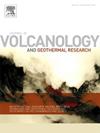模拟沙盒试验研究了直径1 ~ 10 km的破火山口沉降过程中下凹陷和活门构造的时空发育
IF 2.4
3区 地球科学
Q2 GEOSCIENCES, MULTIDISCIPLINARY
Journal of Volcanology and Geothermal Research
Pub Date : 2025-02-10
DOI:10.1016/j.jvolgeores.2025.108294
引用次数: 0
摘要
当岩浆库的顶部因岩浆耗尽而坍塌时,火山口就形成了火山洼地。研究容纳室顶沉降的破火山口边界断层的发育对于理解破火山口塌陷事件和预测同期和随后的火山喷发至关重要。由于天然破火山口的地下结构难以观测,因此通常采用模拟沙盒和数值实验以及大地测量数据的反演来重建破火山口结构。近年来的实验和分析研究表明,在火山口边界断层向上扩展的过程中,存在局部的下凹陷,并且活门火山口的断层结构具有高度的可变性。然而,在向上边界断层传播过程中,下凹陷是如何局部化的,以及在火山口崩塌过程中,何时以及为什么会形成活门构造,仍然是一个悬而未决的问题。在这里,我们在一个透明的沙盒中进行模拟沙盒实验,并使用图像分析技术来提供对这些问题的见解。直径1 ~ 10km的火山口比直径较大的火山口(直径数十km)更有利于评估下陷和活门沉降,因为这些火山变形可能被区域构造控制大火山口沉降的地壳变形所掩盖。因此,我们将重点放在直径1-10 km的火山口上,并排除一些因素,如预先存在的应力状态、断层和岩浆流动,以评估下陷和陷门沉降本身的发展。尽管存在这些实验局限性,但我们的实验与天然破火山口一致,并表明随着破火山口沉降的增加,下陷和活门断裂分为四个阶段。(1)下陷开始时,沿下陷区边缘水平位移速度最大。(2)当向外倾斜的逆断层在深部成核并向上扩展时,水平位移速度峰值出现在隐伏断层的地表投影上。(3)当向外倾斜的逆断层到达地表时,破火山口塌陷地块发生活门沉降。(4)最后,当向内倾的正断层在向外倾的逆断层之上成核时,塌陷块体发生第二次活门沉降。第一阶段和第二阶段表明,可以通过下凹陷变形模式预测隐伏破火山口边界断裂的存在和位置。第三和第四阶段在火山口边界断层发育的背景下解释了活门火山口的时间和结构变化。我们的模型将提高火山口结构重建的分辨率和有关岩浆室动力学的相关推断。本文章由计算机程序翻译,如有差异,请以英文原文为准。
The spatiotemporal development of downsag and trapdoor structures during caldera subsidence with 1–10 km in diameter in analogue sandbox experiments
Calderas are volcanic depressions formed when the roof of a magma chamber collapses due to the depletion of magma within the chamber. Investigating the development of caldera boundary faults that accommodate chamber-roof subsidence is crucial for understanding caldera collapse events and predicting contemporaneous and subsequent volcanic eruptions. Because subsurface structures in natural calderas are difficult to observe, analogue sandbox and numerical experiments, and inversions of geodetic data are often used to reconstruct caldera structures. Recent experimental and analytical studies have revealed localized downsag during the upward propagation of caldera boundary faults and that the fault structures of trapdoor calderas are highly variable. However, how downsag becomes localized during upward boundary fault propagation, and when and why trapdoor structures originate during caldera collapse remain open questions. Here, we performed analogue sandbox experiments in a transparent sandbox and used image analysis techniques to provide insights into these questions. Calderas with 1–10 km in diameter are more favorable than larger ones (tens of kilometers in diameter) for assessing downsagging and trapdoor subsidence, because these volcanic deformations may be masked by crustal deformation due to regional tectonics controlling large caldera subsidence. We therefore focused on calderas with 1–10 km in diameter, and excluded some factors such as pre-existing stress regimes, faults and magma flow, in order to evaluate the development of downsag and trapdoor subsidence themselves. Despite these experimental limitations, our experiments are in agreement with natural calderas and show that as caldera subsidence increases, downsag and trapdoor faulting evolve in four stages. (1) At the beginning of downsag, the horizontal displacement velocity is greatest along the edge of the downsagging region. (2) As the outward-dipping reverse faults nucleate at depth and propagate upward, the peak of horizontal displacement velocity localizes along the surface projection of the concealed faults. (3) Caldera collapse blocks then undergo trapdoor subsidence when the outward-dipping reverse faults reach the surface. (4) Finally, a second episode of trapdoor subsidence of the collapse block occurs when inward-dipping normal faults nucleate beyond the outward-dipping reverse faults. The first and second stages suggest that the existence and location of concealed caldera boundary faults can be predicted from the downsag deformation pattern. The third and fourth stages explain temporal and structural variations observed in trapdoor calderas in the context of caldera boundary fault development. Our model will improve the resolution of caldera structural reconstructions and associated inferences regarding magma chamber dynamics.
求助全文
通过发布文献求助,成功后即可免费获取论文全文。
去求助
来源期刊
CiteScore
5.90
自引率
13.80%
发文量
183
审稿时长
19.7 weeks
期刊介绍:
An international research journal with focus on volcanic and geothermal processes and their impact on the environment and society.
Submission of papers covering the following aspects of volcanology and geothermal research are encouraged:
(1) Geological aspects of volcanic systems: volcano stratigraphy, structure and tectonic influence; eruptive history; evolution of volcanic landforms; eruption style and progress; dispersal patterns of lava and ash; analysis of real-time eruption observations.
(2) Geochemical and petrological aspects of volcanic rocks: magma genesis and evolution; crystallization; volatile compositions, solubility, and degassing; volcanic petrography and textural analysis.
(3) Hydrology, geochemistry and measurement of volcanic and hydrothermal fluids: volcanic gas emissions; fumaroles and springs; crater lakes; hydrothermal mineralization.
(4) Geophysical aspects of volcanic systems: physical properties of volcanic rocks and magmas; heat flow studies; volcano seismology, geodesy and remote sensing.
(5) Computational modeling and experimental simulation of magmatic and hydrothermal processes: eruption dynamics; magma transport and storage; plume dynamics and ash dispersal; lava flow dynamics; hydrothermal fluid flow; thermodynamics of aqueous fluids and melts.
(6) Volcano hazard and risk research: hazard zonation methodology, development of forecasting tools; assessment techniques for vulnerability and impact.

 求助内容:
求助内容: 应助结果提醒方式:
应助结果提醒方式:


